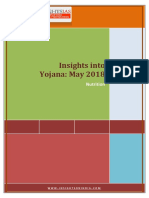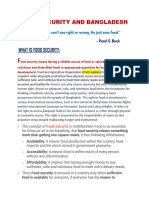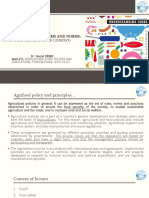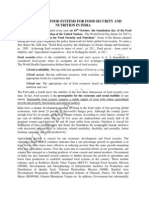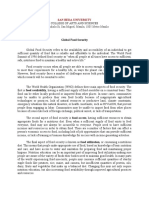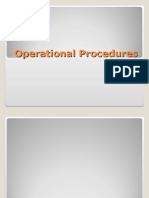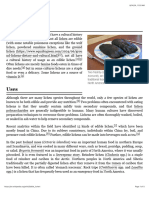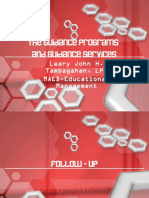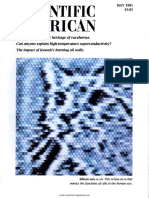0 ratings0% found this document useful (0 votes)
83 viewsFood Policy and Security
Food Policy and Security
Uploaded by
say_himThis document discusses food security management in India. It provides background on the concepts of food security and the current state of food security management in India. The key points are:
1. While India has large food grain stocks, around 200 million people remain underfed and 50 million face starvation. The food security policy aims to ensure affordable access to food.
2. Effective management of food security requires sufficient availability, access, and use of nutritious food. It also requires supportive national policies.
3. Improving food security management requires enhancing agricultural productivity, decentralizing food storage and distribution, improving food access programs, and linking food security with education programs. Transitioning to a decentralized system can improve delivery and reduce
Copyright:
Attribution Non-Commercial (BY-NC)
Available Formats
Download as PDF, TXT or read online from Scribd
Food Policy and Security
Food Policy and Security
Uploaded by
say_him0 ratings0% found this document useful (0 votes)
83 views2 pagesThis document discusses food security management in India. It provides background on the concepts of food security and the current state of food security management in India. The key points are:
1. While India has large food grain stocks, around 200 million people remain underfed and 50 million face starvation. The food security policy aims to ensure affordable access to food.
2. Effective management of food security requires sufficient availability, access, and use of nutritious food. It also requires supportive national policies.
3. Improving food security management requires enhancing agricultural productivity, decentralizing food storage and distribution, improving food access programs, and linking food security with education programs. Transitioning to a decentralized system can improve delivery and reduce
Original Title
Food policy and security
Copyright
© Attribution Non-Commercial (BY-NC)
Available Formats
PDF, TXT or read online from Scribd
Share this document
Did you find this document useful?
Is this content inappropriate?
This document discusses food security management in India. It provides background on the concepts of food security and the current state of food security management in India. The key points are:
1. While India has large food grain stocks, around 200 million people remain underfed and 50 million face starvation. The food security policy aims to ensure affordable access to food.
2. Effective management of food security requires sufficient availability, access, and use of nutritious food. It also requires supportive national policies.
3. Improving food security management requires enhancing agricultural productivity, decentralizing food storage and distribution, improving food access programs, and linking food security with education programs. Transitioning to a decentralized system can improve delivery and reduce
Copyright:
Attribution Non-Commercial (BY-NC)
Available Formats
Download as PDF, TXT or read online from Scribd
Download as pdf or txt
0 ratings0% found this document useful (0 votes)
83 views2 pagesFood Policy and Security
Food Policy and Security
Uploaded by
say_himThis document discusses food security management in India. It provides background on the concepts of food security and the current state of food security management in India. The key points are:
1. While India has large food grain stocks, around 200 million people remain underfed and 50 million face starvation. The food security policy aims to ensure affordable access to food.
2. Effective management of food security requires sufficient availability, access, and use of nutritious food. It also requires supportive national policies.
3. Improving food security management requires enhancing agricultural productivity, decentralizing food storage and distribution, improving food access programs, and linking food security with education programs. Transitioning to a decentralized system can improve delivery and reduce
Copyright:
Attribution Non-Commercial (BY-NC)
Available Formats
Download as PDF, TXT or read online from Scribd
Download as pdf or txt
You are on page 1of 2
International Research Journal , September 2010 ISSN- 0975-3486 RNI: RAJBIL 2009/30097 VOL I * ISSUE 12
Research Paper -- Commerce - Management
FOOD SECURITY MANAGEMENT
A STRATEGIC ISSUE ’
September, 2010 * Dr. Shriprabhu G. Chapke
12345678901234567890123456789012123456789012345678901234567890121234567890123456789012345678901212345678901234567890123456789012123
12345678901234567890123456789012123456789012345678901234567890121234567890123456789012345678901212345678901234567890123456789012123
12345678901234567890123456789012123456789012345678901234567890121234567890123456789012345678901212345678901234567890123456789012123
12345678901234567890123456789012123456789012345678901234567890121234567890123456789012345678901212345678901234567890123456789012123
* *Principal
Assicate Smt.
Prof.Laxmibai
Comm.Dept. Sant Gadge
Radhakisan MaharajCollege
Toshniwal Mahavidyalaya, Walgaom.
of Commerce, Akola
12345678901234567890123456789012123456789012345678901234567890121234567890123456789012345678901212345678901234567890123456789012123
12345678901234567890123456789012123456789012345678901234567890121234567890123456789012345678901212345678901234567890123456789012123
12345678901234567890123456789012123456789012345678901234567890121234567890123456789012345678901212345678901234567890123456789012123
Introduction: consequent negative impact on the health and well-
Food security management is the concept of ‘food being of the rural population.
security which includes both physical and economic Issue of Food Security Management :
access to food that meets people’s dietary needs as well India at present finds itself in the midst of a paradoxical
as their food preferences. situation; endemic mass hunger coexisting with the
Concept of Food Security: mounting food grain stock. The food grain stocks
The World Food Summit -1996 defined Food Security available with the FCI stand at an all-time high of 62
as: “when all people at all times have access to sufficient, million tons against an annual requirement of around 20
safe, nutritious food to maintain a healthy and active million tons for ensuring food security. Still an estimated
life.” Food security involves every individual gaining 200 million people are underfed and 50 million on the
physical, economic, social and environmental access brink of starvation, resulting in starvation death. India’s
to a balanced diet that includes the necessary macro food security policy has a laudable objective to ensure
and micro nutrients, safe drinking water, sanitation, availability of food grains to the common people at an
environmental hygiene, primary health care and affordable price and it has enabled the poor to have
education so as to lead a healthy and protective life. It access to food where none existed. The policy has
is a nutrition security.“Nutrition security involves focused essentially on growth in agriculture production
physical, economic and social access to balanced diet, (once India used to import food grains) and on support
clean drinking water, sanitation and primary health care price for procurement and maintenance of rice and wheat
for every child, woman and man. It is fundamental duty stocks. The responsibility for procuring and stocking
to give all our citizens an opportunity for a healthy and of food grains lies with the FCI and for distribution with
productive life,” said Professor MS Swaminathan, the public distribution system (PDS).
Chairman, MSSRF. Prerequisite of Food Security Management :
Present Scenario of Food Security Management : The foundation of the food security based on three
Food Corporation of India has established Institute of elements: 1 Food availability: Sufficient quantities of
food security in 1971. FCI is maintaining satisfactory food available on a consistent basis. 2 Food access:
level of operational and buffer stock of food grains to Having sufficient resources to obtain appropriate foods
ensure National Food Security. National Food security for a nutritious diet. 3 Food use: Appropriate use based
Mission, State Food Security Mission Executive on knowledge of basic nutrition and care as well as
Committee, District Food Security Mission Executive adequate water and sanitation. It is worth to have detailed
Committee etc. are playing role in food security knowledge of the Food Corporation Act 1964, as its
management. On the composite index of food insecurity basis for a wide spared food security management.
of rural India, states like Jharkhand and Chhattisgarh Corporation Act 1964 are :1 Effective price support
are found in the ‘very high’ level of food insecurity, operations for safeguarding the interests for the farmers.
followed by Madhya Pradesh, Bihar and Gujarat. The 2 Distribution of food grains through out the country
better performers include Himachal Pradesh, Kerala, for public distribution system and 3 Maintaining
Punjab and Jammu and Kashmir. Andhra Pradesh, satisfactory level of operational and buffer stocks of
Madhya Pradesh, Bihar, Gujarat, Karnataka, Orissa and food grains to ensure National Food Security. It is not
Maharashtra perform poorly. Even economically enough to have a good strategy for food security
developed states like Gujarat, Maharashtra, Andhra management but also necessary the supportive national
Pradesh and Karnataka find themselves in the category policy for food security. The national policy of food
of high food insecurity - a reflection perhaps of the security can desire with the enough food that :1 is
manifestation of the agrarian crisis in the states and its affordable, safe and healthy 2 is culturally acceptable
24 fjlpZ ,ukfyfll ,.M boSY ;q,’ku
International Research Journal , September 2010 ISSN- 0975-3486 RNI: RAJBIL 2009/30097 VOL I * ISSUE 12
3 meets specific dietary needs 4 is obtained in a dignified are self-targeting.
manner 5 is produced in way that are environmentally Other measures : 1. To start with, all restrictions on
sound and socially just In the drastic economic food grains regarding inter-State movement, stocking,
changing situation through-out the globes, in many exports and institutional credit and trade financing
countries have failed to improve the food security. should be renounced. Free trade will help make-up the
Variable of Better Food Security Management : difference between production and consumption needs,
The elements of food safety management system are reduce supply variability, increase efficiency in
summarized as under : 1 Food safety policy 2 Prerequisite resource-use and permit production in regions more
programmes 3 Hazard analysis critical control points 4 suited to it. 2. The State government will in turn distribute
Environmental monitoring 5Finished product analysis the grants to the village bodies, which can decide on the
6 Tariff control 7 Preventive maintenance 8 Food allergen list of essential infrastructure, work the village needs
Measure to improve Food Security Management: and allow every needy villager to contribute through
1 Enhancing agriculture productivity: The government, his labour and get paid in food coupons and cash.3.
through investments in vital agriculture infrastructure, Enhancing agricultural productivity and serious affords
credit linkages and encouraging the use of latest for another ‘Green Revolution’ based on best use of
techniques, motivate each district to achieve local self- information technology at various level and with various
sufficiency in food grain production. However, instead dimension. 4. The present system marked by input
of concentrating only on rice or wheat, the food crop subsidies and high MSP should be phased out. To
with a potential in the area must be encouraged. 2 avoid wide fluctuations in prices and prevent distress
Community grain storage banks: The FCI can be selling by small farmers, futures market can be
gradually dismantled and procurement decentralized encouraged. Improved communication systems through
through the creation of food grain banks in each block/ the use of information technology may help farmers get
village of the district, from which people may get a better deal for their produce. Crop insurance schemes
subsidized food grains against food coupons.The grain can be promoted with government meeting a major part
storage facilities can be created within couple of years of the insurance premium to protect the farmers against
under the existing rural development schemes and the natural calamities. Formation of special programme for
initial lot of grains can come from the existing FCI stocks. food security by using information technology. 5.
2 Better Food Management : The community can be Adoption of Food-for-education programme. To achieve
authorized to manage the food banks. This decentralized cent per cent literacy, the food security need can be
management will improve the delivery of entitlements, productively linked to increased enrolment in schools.
reduce handling and transport costs and eliminate With the phasing out of PDS, food coupons may be
corruption, thereby bringing down the issue price issued to poor people depending on their entitlement.
substantially. To enforce efficiency in grain banks 6. Modified food-for-work scheme or direct subsidies
operation, people can also be given an option to obtain should be implemented . With rationalization of input
food grains against food coupons from the open market, subsidies and MSP, the Central Government will be left
if the rates in the grain banks are higher, quality is poor with sufficient funds, which may be given as grants to
or services are deficient. A fund can be set up to reimburse each State depending on the number of poor. 7. Proper
the food retailers for the presented coupons. This implementation of Food Policy with immediate control
competition will lead to constant improvement and lower and feedback policies.
prices. It must also be mandatory to maintain a small Conclusion : -On the background of above facts and
buffer stock at the State level, to deal with exigencies. figure, one has to accept the fact declared in the World
There should be adequate facility for distribution of Food Summit at Rome Declaration (1996) that ‘food
food. There is a need to shift from the existing expensive, security is achieved when all people, at all times, have
inefficient and corruption ridden institutional physical and economic access to sufficient, safe and
arrangements to those that will ensure cheap delivery nutritious food to meet their dietary needs and food
of requisite quality grains in a transparent manner and preferences for an active life’.
1. Report Planning Commission- 9 th Five Year Plan- Govt. of India 2. Report
R E F E R E N C E Planning Commission- 10th Five Year Plan- Govt. of India 3.R. K. Govil Krishi
Arthshastra – 4. Frane F. R. India’s Green Revolution – Economic Gains and
Political Cost- 5. Printice –Hall- Heady, Earlyo. Economics of Agriculture Production and Resources Use- 6. S. Chand, Sundaram
K.P. Indian Economy 7. Indurwade S.H. (2005) What makes the farmers to suicides 8. Sindhu B.S. Land Reforms, Welfare and
Economic Growth 9. Economic Survey 2007-2008 Central Government 10. India development Report 2008 Indira Gandhi
Institutes of Development Research 11. Hindusthan Times, New Delhi 20,May 2006 12. Mahore R.Y.(2005) Farmers distress
and Suicides of farmers in India with reference to Vidarbha 13. Sainath P(2005) Vidarbha: Whose suicidesis it Anyway?
25 RESEARCH ANALYSIS AND EVALUATION
You might also like
- 1yr Employment Bond Agreement Cum Appointment LetterDocument1 page1yr Employment Bond Agreement Cum Appointment LetterPatrick Ryan Teves78% (18)
- Food Security in India - A Detailed Analysis On Its Implications and Government InitiativesDocument6 pagesFood Security in India - A Detailed Analysis On Its Implications and Government InitiativesTripti TiwariNo ratings yet
- National Consultation On SDG-2 - Concept NoteDocument3 pagesNational Consultation On SDG-2 - Concept NoteSAMYUKKTHHA S (RA2252001040009)No ratings yet
- Untitled DocumentDocument16 pagesUntitled Documentsyeda taiba nooraniNo ratings yet
- Environmental Studies.: End Hunger and Achieve Food SecurityDocument20 pagesEnvironmental Studies.: End Hunger and Achieve Food SecurityRishita JalanNo ratings yet
- 2.7 (Food Security in India)Document3 pages2.7 (Food Security in India)BIKRAM SHOWNo ratings yet
- HTTPS:/WWW - Drishtiias.com/daily Updates/daily News Editorials/expandingDocument4 pagesHTTPS:/WWW - Drishtiias.com/daily Updates/daily News Editorials/expandingBal Narayan MeenaNo ratings yet
- Course PlanDocument12 pagesCourse PlanDebasis SahooNo ratings yet
- Farmers Viewpoint On Food SecurityDocument9 pagesFarmers Viewpoint On Food SecurityLeonardo MontemayorNo ratings yet
- Food SecurityDocument10 pagesFood Securitytamilrockers downloadNo ratings yet
- An Empirical Analysis of Pradhan Mantri Garib Kalyan Anna Yojana (PM-GKAY) With Special Reference To Sangli DistrictDocument4 pagesAn Empirical Analysis of Pradhan Mantri Garib Kalyan Anna Yojana (PM-GKAY) With Special Reference To Sangli DistrictInternational Journal of Innovative Science and Research TechnologyNo ratings yet
- Millets YearDocument2 pagesMillets YearnvknsharmaNo ratings yet
- Food Safety in BangladeshDocument45 pagesFood Safety in Bangladeshchaitee1994No ratings yet
- Yojana May 2018Document19 pagesYojana May 2018Sreenu MahanthiNo ratings yet
- Group - 2 - Processed FoodDocument11 pagesGroup - 2 - Processed FoodShivaNo ratings yet
- WFP-Fill The Nutrition Gap in IndonesiaDocument40 pagesWFP-Fill The Nutrition Gap in IndonesiaAlfatehan SeptiantaNo ratings yet
- Yukta Singh 19B184 BSWDocument14 pagesYukta Singh 19B184 BSWYUKTA SINGHNo ratings yet
- Legal Framework Regulating Food Safety - A Critical AppraisalDocument17 pagesLegal Framework Regulating Food Safety - A Critical Appraisalbandla sravanthiNo ratings yet
- FINAL REPORT Food SecurityDocument23 pagesFINAL REPORT Food SecurityAbinash KansalNo ratings yet
- Concept of Food SecurityDocument10 pagesConcept of Food SecurityMd Rejaul IslamNo ratings yet
- Indian Economy-Food SecurityDocument4 pagesIndian Economy-Food SecurityTriptimoy MondalNo ratings yet
- GGBJGJGVDocument15 pagesGGBJGJGVsurya rajputNo ratings yet
- May-018 (Insight Secure Compilation) PDFDocument521 pagesMay-018 (Insight Secure Compilation) PDFnehaNo ratings yet
- Food Security 1Document27 pagesFood Security 1gana.mm66No ratings yet
- Food Security and BangladeshDocument7 pagesFood Security and BangladeshroyshornoNo ratings yet
- Indian Agriculture - Options For Addressing Supply-Side ConstraintsDocument15 pagesIndian Agriculture - Options For Addressing Supply-Side Constraintsrisjha123No ratings yet
- UfoDocument17 pagesUfolekhaNo ratings yet
- EOI - Innovative Ideas (Final)Document5 pagesEOI - Innovative Ideas (Final)Humayun KhanNo ratings yet
- Prateek 113 LandlawDocument6 pagesPrateek 113 Landlawritik chouhanNo ratings yet
- Food Security of IndiaDocument7 pagesFood Security of IndiaGowthami R shettyNo ratings yet
- LectureDocument28 pagesLectureselcen sarıkayaNo ratings yet
- Executive Summary: Chapter 1 - From Crisis To ConfidenceDocument48 pagesExecutive Summary: Chapter 1 - From Crisis To Confidencedivyanshu kumarNo ratings yet
- Sustainable Food Systems For Food Security and Nutrition in IndiaDocument3 pagesSustainable Food Systems For Food Security and Nutrition in IndiaPraveen Kumar ThotaNo ratings yet
- Seminar PPRDocument18 pagesSeminar PPRayushman1898No ratings yet
- Ministry of Research and Development BY Sardar Muhammad AbdullahDocument13 pagesMinistry of Research and Development BY Sardar Muhammad AbdullahwajeehNo ratings yet
- Global Food SecurityDocument7 pagesGlobal Food SecurityMizraim EmuslanNo ratings yet
- Management Strategies For Ensuring Food SecurityDocument13 pagesManagement Strategies For Ensuring Food Securitysalahudeen lawalNo ratings yet
- GE 3 Chapter 6 Lesson 2 Global Food SecurityDocument20 pagesGE 3 Chapter 6 Lesson 2 Global Food Securityjuliet maeNo ratings yet
- Project Proposal On Organic FarmingDocument17 pagesProject Proposal On Organic Farmingani ni mus76% (29)
- Agricultural ExtensionDocument7 pagesAgricultural ExtensionTet Apostol FulgencioNo ratings yet
- Helios - Food Security Act 2013Document11 pagesHelios - Food Security Act 2013acaquarianNo ratings yet
- AssessmentDocument3 pagesAssessmentSAIDA MASAGLANGNo ratings yet
- Food Security Final ReportDocument28 pagesFood Security Final ReportAqsa SarfarazNo ratings yet
- Thesis On Food and Nutrition in IndiaDocument6 pagesThesis On Food and Nutrition in Indiabk32j4wn100% (2)
- The Impact of Government Food Policy On Farm EfficDocument14 pagesThe Impact of Government Food Policy On Farm Efficmarimasssss53No ratings yet
- Food SecurityDocument5 pagesFood SecuritySaurabhNo ratings yet
- Food Security and Sustainability in IndiaDocument7 pagesFood Security and Sustainability in IndiamuskanNo ratings yet
- Macro Economics AND Business EnvironmnetDocument21 pagesMacro Economics AND Business EnvironmnetPavan GautamNo ratings yet
- Ag Modernization Sustainable Ag Phil Ag. EditDocument89 pagesAg Modernization Sustainable Ag Phil Ag. EditJessa Silvano ArgallonNo ratings yet
- Food Security in IndiaDocument7 pagesFood Security in Indiadehra doonNo ratings yet
- 2024 3$thumbimg105 Mar 2024 141131467Document91 pages2024 3$thumbimg105 Mar 2024 141131467sifna pNo ratings yet
- Stabilizing Agriculture MarketsDocument2 pagesStabilizing Agriculture Markets420leaksNo ratings yet
- Food Safety Regulatory Compliance in India: A Challenge To Enhance Agri-BusinessesDocument18 pagesFood Safety Regulatory Compliance in India: A Challenge To Enhance Agri-BusinessesMuammarNo ratings yet
- India's Approach To Food Security Resilience Amid COVID-19: Relevance To ASEAN? NTS Insight 2022Document11 pagesIndia's Approach To Food Security Resilience Amid COVID-19: Relevance To ASEAN? NTS Insight 2022Jose MaNo ratings yet
- Food SecurityDocument26 pagesFood SecurityAqsa SarfarazNo ratings yet
- Kurukshetra August 2023 f0f9b350d6Document17 pagesKurukshetra August 2023 f0f9b350d6mydogpilluNo ratings yet
- Synergy Between Food Security Act and NREGADocument3 pagesSynergy Between Food Security Act and NREGArohit vyasNo ratings yet
- Kurukshetra Summary July 2023.doxDocument20 pagesKurukshetra Summary July 2023.doxRoshan SharmaNo ratings yet
- TCW Module 12 Global Food SecurityDocument2 pagesTCW Module 12 Global Food SecurityRizza valenciaNo ratings yet
- Soil Report - ThankotDocument67 pagesSoil Report - ThankotSaumya ShresthaNo ratings yet
- SepsisDocument24 pagesSepsislipu1982No ratings yet
- English PresentationDocument4 pagesEnglish PresentationEmptygal Ling YamNo ratings yet
- Chapter 2, Lesson 1 Activity Sheet AnswersDocument2 pagesChapter 2, Lesson 1 Activity Sheet Answersjustin pastidioNo ratings yet
- Science G9 Q2 W3 ModDocument8 pagesScience G9 Q2 W3 ModRhia Mae AjocNo ratings yet
- Genetics NotesDocument20 pagesGenetics Noteslebohangcandy8No ratings yet
- Chapter - Drug House ManagementDocument18 pagesChapter - Drug House Managementmifuo100% (1)
- Lesson Plan in Health IV JonaDocument8 pagesLesson Plan in Health IV JonaJenelyn Limen100% (1)
- PPL OpDocument122 pagesPPL OpBea AlduezaNo ratings yet
- Xii RecordDocument24 pagesXii RecordfNo ratings yet
- Edible Lichen - WikipediaDocument5 pagesEdible Lichen - WikipediaappamanodhammoNo ratings yet
- Independence Day SpeechDocument8 pagesIndependence Day SpeechSabir Mhd0% (1)
- A Review On Role of Bio-Fertilizers in Fruit Crops: Plant ArchivesDocument5 pagesA Review On Role of Bio-Fertilizers in Fruit Crops: Plant ArchivesParth HatiskarNo ratings yet
- Alano, Dhan Daryl B. Insurance Law Law 3DDocument5 pagesAlano, Dhan Daryl B. Insurance Law Law 3DJuan VillanuevaNo ratings yet
- Fundamental Principles of International Humanitarian LawDocument3 pagesFundamental Principles of International Humanitarian LawAyban NabatarNo ratings yet
- The Guidance Programs and Guidance ServiDocument24 pagesThe Guidance Programs and Guidance ServiLeary John TambagahanNo ratings yet
- Silicosis PDFDocument1 pageSilicosis PDFGibson SindoweNo ratings yet
- Prevalence of Anaemia Among Adolescent Girls: A Cross Sectional Exploratory StudyDocument3 pagesPrevalence of Anaemia Among Adolescent Girls: A Cross Sectional Exploratory StudyJamilaNo ratings yet
- Institute and Faculty of Actuaries: Subject CT5 - Contingencies Core TechnicalDocument20 pagesInstitute and Faculty of Actuaries: Subject CT5 - Contingencies Core TechnicalKashif KhalidNo ratings yet
- Breast CancerDocument2 pagesBreast CanceryeldamukhtarNo ratings yet
- Digital Timer Modulator With Diagnostic Readout: Operating Instructions (701 10 Series)Document4 pagesDigital Timer Modulator With Diagnostic Readout: Operating Instructions (701 10 Series)Alex ConstantinescuNo ratings yet
- Gurdrail ManualDocument16 pagesGurdrail ManualMohamedNo ratings yet
- Seminar ON Cardiopulmonary Resuscitation: Submitted To Submitted byDocument18 pagesSeminar ON Cardiopulmonary Resuscitation: Submitted To Submitted bymerin sunilNo ratings yet
- 1991-05-01 PDFDocument140 pages1991-05-01 PDFNipun MohanNo ratings yet
- Materials List 1Document226 pagesMaterials List 1KaJong Jacla100% (1)
- CLASS PROGRAM G11 LevelDocument5 pagesCLASS PROGRAM G11 LevelPetRe Biong PamaNo ratings yet
- Inotropes + Electrolyte Imbalance: Presented By: Asya AmeenDocument53 pagesInotropes + Electrolyte Imbalance: Presented By: Asya AmeenAsia AmeenNo ratings yet
- Generic HACCP Models For FoodDocument18 pagesGeneric HACCP Models For FoodNatalia Lajca100% (1)
- CMAS BOD Removal-Nitrif Design-SIDocument27 pagesCMAS BOD Removal-Nitrif Design-SIChamika JayasekeraNo ratings yet













